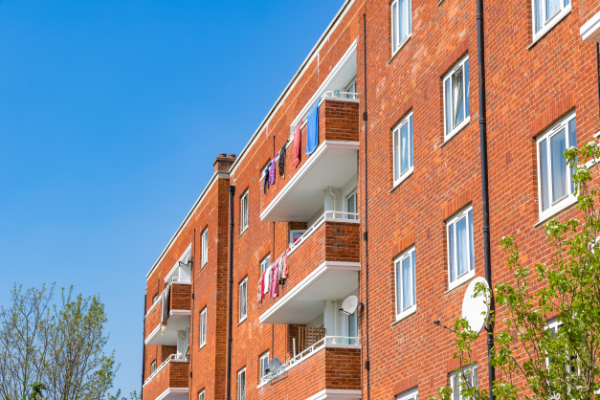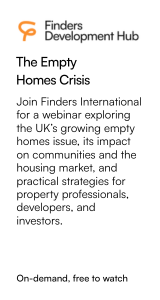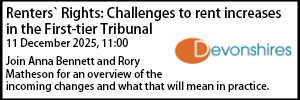Remembering mediation in housing cases
- Details
 Sarah Salmon considers a High Court judge’s “lessons for the future” in a recent dispute over interpretation of tenancy agreement.
Sarah Salmon considers a High Court judge’s “lessons for the future” in a recent dispute over interpretation of tenancy agreement.
As the Government focus on litigation with their “call for evidence” in “Considering the case for a Housing Court” (here), one thing that is often overlooked in housing cases is the availability of mediation. It is, of course, right to say that mediation is not always suitable for housing cases but there are some areas for which is could work quite well and, if successful, would reduce the costs to the parties of conducting litigation through to trial. One such area is disrepair. Another area, as suggested by Mr Justice Harry Carr in the recent case of Network Homes Ltd v Harlow [2018] EWHC 3120 (Ch), is where there is a dispute over the correct interpretation of a term of a tenancy agreement.
The case of Network Homes v Harlow is not a million miles away from a disrepair claim; it concerned the correct interpretation of an access provision in a tenancy agreement. The reason why Network Homes required “access”, however, was for the installation of a new front door due to fire safety concerns (fire safety being one of the top priorities of most social landlords since the tragedy at Grenfell). Mr Harlow was not prepared to provide access to his flat, Flat 25, situated within a sheltered housing scheme (“the scheme”), for the installation of the door.
Mr Harlow suffers from impaired vision and he was concerned that the locks on the fire doors which had been installed in the other flats within the scheme would be difficult for him to open and close. He was also anxious that he will be unable to get out of his flat, or others will be unable to get in to help him.
Relevant terms of the tenancy
The relevant terms of the tenancy agreement are set out at [5]-[11] of the judgment available here. “The Property” was defined in the tenancy agreement as Flat 25.
Clause 2.1 – “Tenant’s right to occupy” – provided:
“We will give you possession of the Property from commencement of the tenancy. We will not interfere with your right to occupy the Property unless we need to gain access in circumstances set out in clause 3.18 or legal action is commenced to demote or terminate your tenancy.”
It was noted in the judgment, as it was at first instance, that the reference to clause 3.18 was “an obvious error in the drafting of the Tenancy Agreement” and should be a cross-reference to clause 3.19: judgment at [7]. In the clauses which follow, taken from the judgment, Mr Justice Harry Carr made the correction.
Clause 2.2 – “Repair of structure and exterior” – provided that the landlord will keep in good repair the structure and exterior of the Property (Flat 25).
Clause 2.2 further provided that:
“We retain the right to carry out any repair, maintenance or improvement works which are not required by this clause but which we decide to carry out to improve the Property or the building or estate in which the Property is situated.”
Clauses 3.1-3.23 set out the tenant’s obligations. Clause 3.2 – “Possession” – set outs as far as relevant:
“You have the right to occupy the Property without interruption or interference from us for the duration of the tenancy (except for the obligation contained in clause [3.19] to give access to us, our agents or contractors) so long as you comply with this agreement…”
Clause 3.19 is the term headed “Access” and it provided that:
“You must give all authorised employees and agents of Willow Housing and Care Ltd [Network Homes’ predecessor in title] reasonable access to the Property to inspect or carry out essential maintenance, inspection and repair to the Property or to the building or estate in which the Property is situated. This includes treatment programs for pest eradication, improvement work and access to repossess your home if it is to be redeveloped or disposed of.”
First instance
Mr Harlow succeeded in the county court. His Honour Judge Jan Luba QC refusing Network Homes’ application for an injunction for access held, inter alia, the following.
(a) Clause 2.2 was primarily concerned with repairs, including safety checks and that, whilst it did give the landlord the right to carry out improvement works, it did not contain a concurrent obligation on the tenant to permit such access. As “access” was expressly provided for elsewhere in the Tenancy Agreement, it was not appropriate for him to imply a right for the landlord to access the property to undertake improvements into clause 2.2: judgment at [14].
(b) Clause 3.19 did not give a right of access to the landlord for the purpose of carrying out improvements to the property: judgment at [15]-[16]. In concluding that the right of access was limited to “landlord’s notification of intention to inspect”; “in response to a landlord’s notification of intention to repair”; and, “to give access in response to the landlord’s request to “carry out essential maintenance””, he noted the “obvious mismatch” between clause 3.19 and clause 2.2, which permitted the landlord to enter for repair, maintenance or improvement works.
(c) A right of access should not be implied to give effect to clause 2.2 concerning the landlord’s reservation of the right to carry out improvement work: judgment at [20]-[21].
The Appeal
The appeal was allowed on ground one which was that “clause 3.19 ought to be construed as obliging tenants to grant access so that the landlord can improve (i.e. replace) the front door”: judgment at [22].
Mr Justice Harry Carr concluded that the tenancy agreement provided a right of access to Network Homes for the purpose of performing improvement works which would include replacing the front door of Mr Harlow’s flat: judgment at [38]. In so concluding, he stated (amongst other things) that:
- it was necessary to bear in mind, when considering clause 3.19, that the tenancy agreement was poorly drafted; the court should be more willing to depart from the natural meaning of the words chosen than when considering a carefully drafted document;
- the tenancy agreement should be construed as a whole to give it commercial coherence;
- clause 3.19 must include a right of access for the purposes specified in the second sentence: pest eradication, improvement work and access to repossess the tenant’s home if it is to be
- it was relevant that the tenancy was granted by a social housing landlord for one unit in a building with multiple occupancy. A reasonable person would expect the landlord to be able to ensure the safety of all residents of the building, and to be able to require access to individual units for that purpose: judgment at [28]-[38].
Mediation
At the end of his judgment at [48]-[49], Mr Justice Harry Carr set out his “lessons for the future”. Without knowledge of whether the parties had considered mediation, the Judge stated that a case of this type would have been “eminently suitable for mediation”. He set out a hope that in similar cases mediation would be considered at “a very early stage of proceedings”. In airing his concerns, he noted that the case had been the subject of three hearings “at considerable cost” to Network Homes, a charity, as well as the costs for Mr Harlow in the county court who had been publicly funded.
The case is yet another reminder of the court’s stance on mediation and, although a case may not be right for mediation or mediation may fail, serves as a reminder to landlords and tenants that it might be worth trying in certain cases to save the costs of going to trial.
Sarah Salmon is a barrister at Field Court Chambers. She can be contacted




































